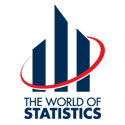October 2009
Contents:
- Seminars, Conferences, Symposia & Call For Papers:
- 19th Annual Morris Hansen Lecture (October 13, 2009)
- 110th Meeting of the Committee on National Statistics (October 29-30, 2009)
- Federal Committee on Statistical Methodology 2009 Research Conference (November 2-4, 2009)
- Info-Metrics Institute Workshop (November 20, 2009)
- 2010 International Conference on Social Computing, Behavioral Modeling, & Prediction (SBP10- March 29 to April 1, 2010)
- Upcoming Seminars
- Education Announcements:
- Short Courses (includes JPSM short courses)
- SIGSTAT Topics
- Note From The WSS NEWS Editor
- WSS People
- PDF Version:
Newsletter
Area Meetings and Courses
110th Meeting of the Committee on National Statistics
October 29-30, 2009
Thursday October 29, 2009
A business meeting from 9:00 am Ð 5:15 am, followed by a dinner for members and guests.
Friday, October 30, 2009
A business meeting, beginning at 8:30 am, followed by lunch with the statistical agency heads at 12:30 and a public seminar from 2:00 Ð 4:00 pm, ending with a reception.
| 1:30 p.m. | Light refreshments for seminar guests (first floor prefunction space) |
| 2:00 p.m. | Welcome Bill Eddy, CNSTAT Chair and Carnegie Mellon University |
| 2:05 p.m. | Developments at the OMB Statistical and Science Policy Office Katherine K. Wallman, Chief Statistician Featured Topic: Challenges for Policy Uses of Economic Statistics Chair: John Haltiwanger, CNSTAT and University of Maryland |
| 2:20 p.m. | Using Current Economic Statistics for Understanding the Business Cycle - All You Wanted to Know about the NBER "Recession Dating" Process David Romer, Professor of Economics, University of California at Berkeley |
| 2:40 p.m. | Using Current Economic Statistics for Economic Policy-Making Rebecca Blank, Under Secretary for Economic Affairs, U.S. Department of Commerce |
| 3:00 p.m. | Perspectives from the Producer Agencies Keith Hall, Commissioner, Bureau of Labor Statistics Steven Landefeld, Director, Bureau of Economic Analysis Thomas Mesenbourg, Deputy Director, U.S. Census Bureau |
| 3:40 p.m. | Floor discussion ) |
| 4:00 p.m. |
Reception for seminar guests 3rd floor Atrium |
| 5:00 p.m. | Adjourn |
Abstract: The federal statistical system produces key statistics that are widely used for monitoring the health of the nation's economy and formulating economic policy. Data users want statistics that are up to date, issued frequently (monthly, if possible), of high quality, and that can indicate turning points in the business cycle a tall order, indeed. David Romer, a member of the National Bureau of Economic Research's "Business Cycle Dating Committee," will describe how that committee uses economic indicators to date peaks and troughs denoting expansions and recessions in the U.S. economy, and where the committee would most like to see data improvements made. Rebecca Blank will discuss how the administration uses economic statistics to determine economic policy and what improvements in quality, timeliness, and relevance would be most helpful for this purpose. Senior managers from the key economic statistics-producing agencies, including the Bureau of Economic Analysis, the Bureau of Labor Statistics, and the Census Bureau, will offer their perspectives. Key concerns to be addressed by all speakers are the tradeoffs between timeliness of release and quality (as reflected in the magnitude of revisions) and what new or modified indicators could help predict turning points, such as last year's financial collapse.
NOTE: All venues are handicapped-accessible. There is first-come, first-served parking on the first floor of the Keck parking garage, entrance on 6th St between E and F. Pedestrian entrance is on 5th St between E and F.
The nearest Metro station is Gallery Place (Red and Green/Yellow lines; arena exit at 7th and F Sts).
Please RSVP by October 28th to Bridget Edmonds at 202-334-3096 or cnstat@nas.edu.
Return to top
Federal Committee on Statistical Methodology
2009 Research Conference
November 2-4, 2009
The 2009 Federal Committee on Statistical Methodology (FCSM) Research Conference will be held November 2-4, 2009 at the Washington Conventions Center, 801 Mount Vernon Place NW, Washington, DC. The Conference provides a forum for experts from around the world to discuss and exchange current research and methodological topics relevant to Federal government statistical programs. Each day of the conference will offer papers on a wide range of topics including the use of advanced technologies for survey design and data collection, processing and dissemination, data mining, data warehousing and metadata, treatment of missing data, improving coverage and response rates, confidentiality and disclosure issues, record linkage, sample design and estimation, cognitive research and usability testing, and data quality.
Technical demonstrations will run concurrently on the second day of the conference during the first morning session. Applications will include demonstrations on Q-Notes, Demonstration of Field Interviewer (Fl) Tracker Tool, Statipedia, and a Demonstration of Census Coverage Measurement Clerical Matching Software. Sessions feature papers and demonstrations by government, private sector, and academic researchers from eight countries. Katharine Abraham from the Joint Program in Survey Methodology at the University of Maryland will be our guest speaker in the opening plenary session. All paper sessions will include an open discussion and some sessions will include a formal discussion.
Conference Fee: Registration is $195. For a copy of the advance program and registration information please refer to http://www.fcsm.gov/events/
Return to topSIGSTAT Topics for Fall/Winter 2009-2010
October 14, 2009: PROC COUNTREG
(http://support.sas.com/documentation/cdl/en/etsug/60372/HTML/default/countreg_toc.htm)
he COUNTREG (count regression) procedure analyzes regression models in which the dependent variable takes nonnegative integer or count values. The dependent variable is usually an event count, which refers to the number of times an event occurs. For example, an event count might represent the number of ship accidents per year for a given fleet. In count regression, the conditional mean E(yi | xi) of the dependent variable, yi , is assumed to be a function of a vector of covariates, xi . The Poisson (log-linear) regression model is the most basic model that explicitly takes into account the nonnegative integer-valued aspect of the outcome.
With this model, the probability of an event count is determined by a Poisson distribution, where the conditional mean of the distribution is a function of a vector of covariates. However, the basic Poisson regression model is limited because it forces the conditional mean of the outcome to equal the conditional variance. This assumption is often violated in real-life data. Negative binomial regression is an extension of Poisson regression in which the conditional variance may exceed the conditional mean.
Also, an often encountered characteristic of count data is that the number of zeros in the sample exceeds the number of zeros predicted by either the Poisson or negative binomial model. Zero- inflated Poisson (ZIP) and zero-inflated negative binomial (ZINB) models explicitly model the production of zero counts to account for excess zeros and also enable the conditional variance of the outcome to differ from the conditional mean. Under zero-inflated models, additional zeros occur with probability ¡i , which is determined by a separate model, ¡i = F(z'i ) where F is the normal or logistic distribution function resulting in a probit or logistic model, and zi is a set of covariates.
November 18, 2009: SAS for Forecasting Time Series: Part 1
(http://support.sas.com/publishing/bbu/companion_site/57275.html)
This month begins a series of meetings on the topic using SAS to forecast time series. We follow the book titled "SAS for Forecasting Time Series 2nd Edition" by Brocklebank and Dickey.
Part 1: This month covers Chapter 1: Overview of Time Series and Chapter 2: Simple Models: Autoregression . Topics include regression with autocorrelated error terms, transformations to stabilize the variance, forecasting with PROC ARIMA, the backshift operator B, and the Yule-Walker equations.
December 16, 2009: SAS for Forecasting Time Series: Part 2
(http://support.sas.com/publishing/bbu/companion_site/57275.html)
This month continues a series of meetings on the topic using SAS to forecast time series. We follow the book titled "SAS for Forecasting Time Series 2nd Edition" by Brocklebank and Dickey.
Part 2: This month begins Chapter 3: The General ARIMA Model. Topics include prediction and model identification.
January 20, 2010: SAS for Forecasting Time Series: Part 3
(http://support.sas.com/publishing/bbu/companion_site/57275.html)
This month continues a series of meetings on the topic using SAS to forecast time series. We follow the book titled "SAS for Forecasting Time Series 2nd Edition" by Brocklebank and Dickey.
Part 3:This month continues Chapter 3: The General ARIMA Model. Topics include using the IDENTIFY and ESTIMATE statements with a number of examples.
February 24, 2010: SAS for Forecasting Time Series: Part 4
(http://support.sas.com/publishing/bbu/companion_site/57275.html)
This month continues a series of meetings on the topic using SAS to forecast time series. We follow the book titled "SAS for Forecasting Time Series 2nd Edition" by Brocklebank and Dickey.
Part 4: This month continues Chapter 3: The General ARIMA Model. Topics include models for nonstationary data and differencing to remove a linear trend.
March 17, 2010: SAS for Forecasting Time Series: Part 5
(http://support.sas.com/publishing/bbu/companion_site/57275.html)
This month continues a series of meetings on the topic using SAS to forecast time series. We follow the book titled "SAS for Forecasting Time Series 2nd Edition" by Brocklebank and Dickey.
Part 5: This month begins Chapter 4: The ARIMA Model: Introductory Applications. Topics include an introduction to seasonal modeling and model identification.
SIGSTAT is the Special Interest Group in Statistics for the CPCUG, the Capital PC User Group, and WINFORMS, the Washington Institute for Operations Research Service and Management Science.
All meetings are in Room S3031, 1800 M St, NW from 12:00 to 1:00. Enter the South Tower & take the elevator to the 3rd floor to check in at the guard's desk.
First-time attendees should contact Charlie Hallahan, 202-694-5051, hallahan@ers.usda.gov, and leave their name. Directions to the building & many links of statistical interest can be found at the SIGSTAT website, http://www.cpcug.org/user/sigstat/.
Return to top-->
Note From The WSS NEWS Editor
Items for publication in the November issue of the WSS NEWS should be submitted no later than October 22, 2009. E-mail items to Michael Feil at michael.feil@usda.gov.
Return to topClick here to see the WSS Board Listing (pdf)
Return to top






